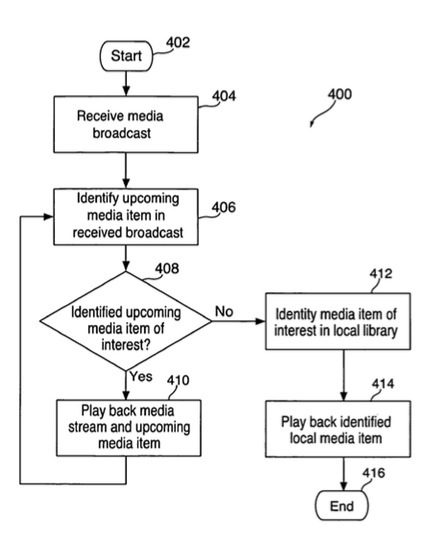An Apple patent (number 8249497) for seamless switching between radio and local media has appeared at the U.S. Patent & Trademark Office. As it involves technology that lets users skip unwanted audio and video broadcast segments such as commercials it may hint at features of an upcoming revamp of the Apple TV set-box box or the rumored “iTV.”
Per the patent, systems and methods are provided for seamlessly switching media playback between a media broadcast, such as a radio broadcast, and media from a local media library. When an electronic device determines that an upcoming media item in a media broadcast is not of interest to a user, the electronic device can switch playback from the media stream to a media item from the electronic device local library.
The selected local media item can be related to a previously broadcast media item to ensure continuity in the user’s listening or viewing experience. The electronic device can switch away from the local media item and return to the media stream when the media stream again broadcasts media items or segments of interest to the user.
Here’s Apple’s background and summary of the invention: “Using a radio system, a user can receive radio waves broadcast from a radio station and provide an audio output associated with the received radio waves. Similarly, an electronic device can use communications circuitry to receive media broadcasts from non-radio media or content sources. The content of a particular radio broadcast, or more generally of a media broadcast, can vary with time.
“For example, a media broadcast can include a succession of different media items (e.g., different songs). As another example, a media broadcast can include a succession of segments (e.g., a succession of conversations or interviews with different guests). As still another example, a media broadcast can include content provided by advertisers that is interspersed between media items.
“A user, however, may not be interested in every media item provided as part of a broadcast stream. For example, a user may not like a particular song broadcast by a radio station, or may not like a particular segment of a talk radio station (e.g., the user does not like the topic or guest of the segment). As another example, a user may not be interested in content originally generated by sources other than the media source (e.g., advertisement content). Because the user has no control over the media broadcast, the user can typically only tune to a different media broadcast, or listen to or consume the broadcast content that is not of interest.
“This is directed to systems, methods, devices and computer readable media for seamlessly switching the playback of media between a broadcast media stream and media locally available to an electronic device. For example, the broadcast stream can include a radio stream provided over any communications network, and the locally available media can include media locally stored in memory or storage of the electronic device, or media items available as a dedicated unicast stream (e.g., from a host device) to the electronic device.
‘To allow a user to only consume the media items of interest in a media broadcast, the electronic device can determine when an upcoming broadcast segment or media item is not of interest to the user, and switch the playback from the media broadcast to media items locally stored on (e.g., stored in memory) or accessible to the electronic device (e.g., available as an on-demand stream from the user’s host device). The electronic device can identify the current and future media items to be broadcast using any suitable approach.
‘In some embodiments, the electronic device can identify specific media items, broadcast segments, or broadcast elements from metadata broadcast along with the media items (e.g., Radio Data System, or RDS data), broadcast listings or schedules available from or published by one or more media sources, analysis of the audio or video provided by the content source (e.g., audio analysis to identify a song or voice), or any other approach.
‘The electronic device can determine which media items are of interest to a user, or are not of interest to the user using any suitable approach. For example, the electronic device can compare media items to a user preference profile generated for each user of an electronic device. The preference profile can include any suitable information, including for example metadata values describing media items of interest or not of interest (e.g., preferred or disliked genres, artists, media types), specific media items (e.g., media items in which the user has indicated a level of interest or disinterest), or any other suitable information for determining a user’s media interests. The preference profile can be generated using any suitable approach, including for example monitoring a user’s playback history, requesting response to a questionnaire, or any other suitable approach.
‘When the electronic device determines that a current or upcoming media item in a broadcast stream is not of interest to a user, the electronic device can identify an appropriate local media item to play back instead of the media stream. In some embodiments, the electronic device can apply a relevance algorithm to select a particular media item that is of interest to the user. For example, the electronic device can apply the relevance algorithm to the last media item of interest of the media stream to select a locally stored media item. This may ensure that the user is provided with a substantially coherent media consumption experience.”
The inventors are Michael L. Ingrassia and Jeffery T. Lee.





